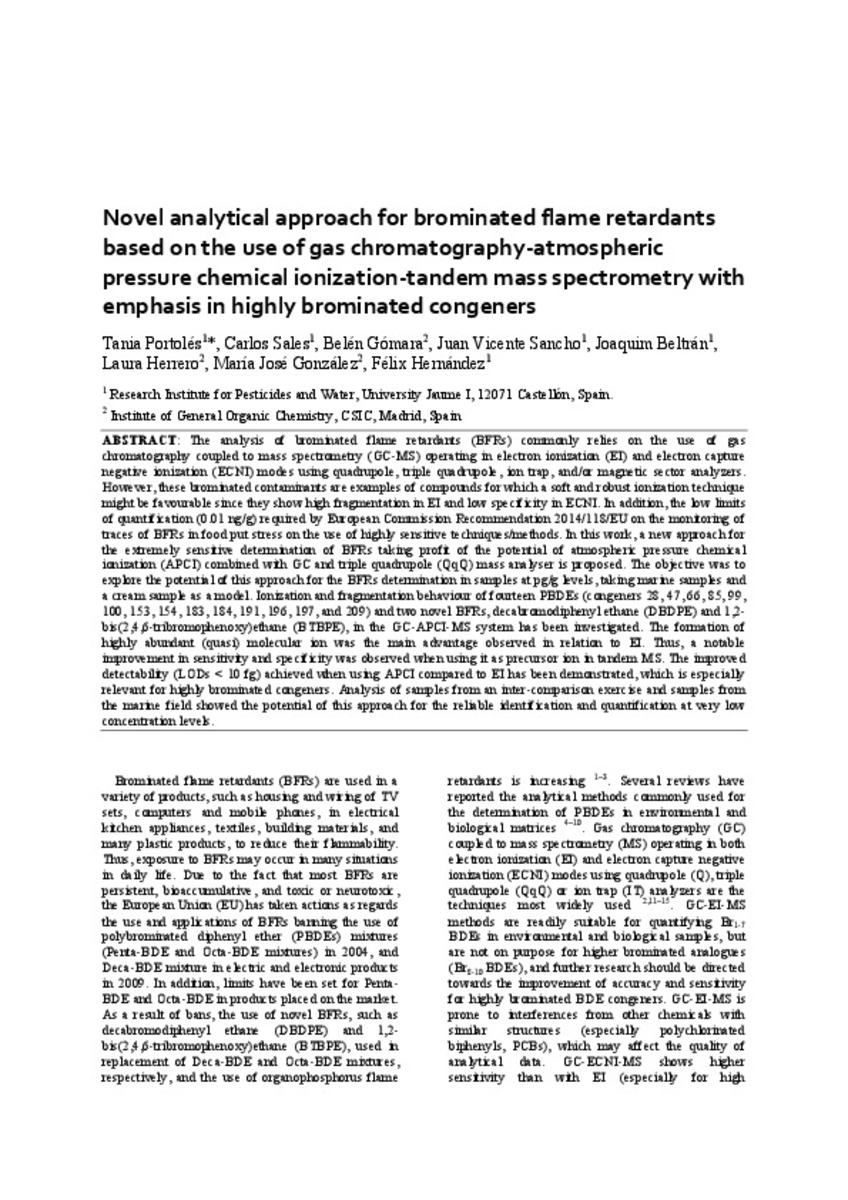Mostrar el registro sencillo del ítem
Novel analytical approach for brominated flame retardants based on the use of gas chromatography-atmospheric pressure chemical ionization-tandem mass spectrometry with emphasis in highly brominated congeners
| dc.contributor.author | Portoles, Tania | |
| dc.contributor.author | Sales Martínez, Carlos | |
| dc.contributor.author | Gomara, Belén | |
| dc.contributor.author | Sancho, Juan V | |
| dc.contributor.author | Beltran Arandes, Joaquin | |
| dc.contributor.author | Herrero, Laura | |
| dc.contributor.author | González, María José | |
| dc.contributor.author | Hernandez, Felix | |
| dc.date.accessioned | 2015-12-14T12:27:18Z | |
| dc.date.available | 2015-12-14T12:27:18Z | |
| dc.date.issued | 2015 | |
| dc.identifier.issn | 0003-2700 | |
| dc.identifier.issn | 1520-6882 | |
| dc.identifier.uri | http://hdl.handle.net/10234/143446 | |
| dc.description.abstract | The analysis of brominated flame retardants (BFRs) commonly relies on the use of gas chromatography coupled to mass spectrometry (GC-MS) operating in electron ionization (El) and electron capture negative ionization (ECNI) modes using quadrupole, triple quadrupole, ion trap, and magnetic sector analyzers. However, these brominated contaminants are examples of compounds for which a soft and robust ionization technique might be favorable since they show high fragmentation in El and low specificity in ECNI. In addition, the low limits of quantification (0.01 ng/g) required by European Commission Recommendation 2014/118/EU on the monitoring of traces of BFRs in food put stress on the use of highly sensitive techniques/methods. In this work, a new approach for the extremely sensitive determination of BFRs taking profit of the potential of atmospheric pressure chemical ionization (APCI) combined with GC and triple quadrupole (QqQ) mass analyzer is proposed. The objective was to explore the potential of this approach for the BFRs determination in samples at pg/g levels, taking marine samples and a cream sample as a model. Ionization and fragmentation behavior of 14 PBDEs (congeners 28, 47, 66, 85, 99, 100, 153, 154, 183, 184, 191, 196, 197, and 209) and two novel BFRs, decabromodiphenyl ethane (DBDPE) and 1,2-bis(2,4,6-tribromophenoxy)ethane (BTBPE), in the GC-APCI-MS system has been investigated. The formation of highly abundant (quasi) molecular ion was the main advantage observed in relation to EI. Thus, a notable improvement in sensitivity and specificity was observed when using it as precursor ion in tandem MS. The improved detectability (LODs < 10 fg) achieved when using APCI compared to El has been demonstrated, which is especially relevant for highly brominated congeners. Analysis of samples from an intercomparison exercise and samples from the marine field showed the potential of this approach for the reliable identification and quantification at very low concentration levels. | ca_CA |
| dc.description.sponsorShip | Generalitat Valenciana: PROMETEO/2009/054 ; Prometeo II 2014/023; Collaborative Research on Environment and Food Safety : ISIC/2012/016 ; Spanish Ministry of Economy and Competitiveness and European from FEDER Program: AGL2012-37201 ; 52013/ABI-3028 | ca_CA |
| dc.format.mimetype | application/pdf | ca_CA |
| dc.language.iso | eng | ca_CA |
| dc.publisher | American Chemical Society | ca_CA |
| dc.relation.isPartOf | Analytical Chemistry , vol. 87. núm. 19 | ca_CA |
| dc.rights.uri | http://rightsstatements.org/vocab/CNE/1.0/ | * |
| dc.subject | Polybrominated diphenyl ethers | ca_CA |
| dc.subject | polychlorinated-biphenyls | ca_CA |
| dc.subject | human samples | ca_CA |
| dc.subject | water | ca_CA |
| dc.subject | fish | ca_CA |
| dc.subject | PBDES | ca_CA |
| dc.subject | MS | ca_CA |
| dc.title | Novel analytical approach for brominated flame retardants based on the use of gas chromatography-atmospheric pressure chemical ionization-tandem mass spectrometry with emphasis in highly brominated congeners | ca_CA |
| dc.type | info:eu-repo/semantics/article | ca_CA |
| dc.identifier.doi | http://dx.doi.org/10.1021/acs.analchem.5b02378 | |
| dc.rights.accessRights | info:eu-repo/semantics/openAccess | ca_CA |
| dc.relation.publisherVersion | http://pubs.acs.org/doi/abs/10.1021/acs.analchem.5b02378 | ca_CA |
| dc.edition | postprint | ca_CA |
| dc.type.version | info:eu-repo/semantics/acceptedVersion |
Ficheros en el ítem
Este ítem aparece en la(s) siguiente(s) colección(ones)
-
IUPA_Articles [306]







